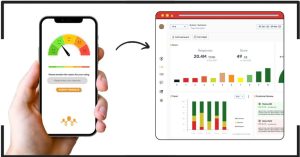Customer sentiment is the window to the inner thoughts of a customer. What do they think of the service or the product? Did they appreciate the customer service representative? The only way to find out is via a feedback survey and sentiment analysis on their responses. In this blog, we will discuss sentiment analysis and how it can upgrade customer experience.
What is Sentiment Analysis?
Sentiment analysis in customer feedback will segregate responses into three major emotions- positive, negative and neutral. A sentiment analysis tool uses natural language processing (NLP) that can comprehend and replicate human language.
Customer sentiment analysis can be done on call transcripts, chatbot conversations, social media conversations and human interactions. These conversations provide insights on customer emotions.
Why is Customer Sentiment Analysis Important?
Sentiment analysis can assess emotional metrics in customer satisfaction surveys or during conversations with a customer support executive. Here is why analyzing a customer’s emotional metric is a much needed step for customer experience.
1. Humanizing customer service with customization:
Customers are people with feelings, purchasing desires and charged emotions. Market standard metrics of Net Promoter Score, customer satisfaction score and customer effort score is always not enough. Humanizing customer service is the first step to offering a human touch in a brand-buyer relationship.
For example, Zappos, a popular footwear brand, remained on call with their customer for 18 hours just to help them find the right pair of shoes for their wedding. Humanizing support systems can make a lot of difference especially when customers are looking for humanized solutions to unique issues.
2. Boosting marketing campaigns’ ROI:
Customer sentiment analysis can help optimize marketing campaigns. Businesses can tailor their approach to resonate with positive customer sentiment. Use sentiment analysis algorithms to identify pertinent information for targeted campaigns. Moreover, positive feedback contributes to the effectiveness of marketing campaigns.

3. Improve products and services with feedback:
Negative experiences can cause a high rate of customer churn. People often share their pain points before they switch over to their competitors. One way to prevent churn is to capture their emotions at the early stage of the customer journey. Each moment of truth can bring a new highlight and insight. If people are not satisfied or face neglect after product usage, they may rate your services poorly. Using sentiment analysis on customer feedback can highlight pain points, negative emotions and give insights into a user’s motivations. This is a great metric to help improve products, services and overall customer experience.
4. Manage brand reputation:
Effective brand reputation management includes identifying significant shifts in sentiment data. This guides brand reputation management and provides valuable input for marketing campaigns and product enhancements. As per research, 92% of global consumers show their appreciation via friends/ family/ peers recommendations- this is greater than other types of advertising. Tackling negative emotions with empathy and feasible solutions can encourage consumers to spread positive word-of-mouth for better brand reputation.
Implementing Customer Sentiment Analysis
Use a sentiment analysis tool to assess survey responses and classify multimedia feedback.
1. Get customer feedback with live chatbots:
Website live chatbot provides real-time data for sentiment analysis. Use a customer sentiment analysis tool during live chat. This will give you a detailed insight on the emotional responses of your user base. This is a valuable method to monitor and analyze customer sentiments during support interactions.
2. Social media conversations can capture user emotions:
Social media conversations provide real-time data into customer sentiments. Analyzing brand mentions on Google reviews, Twitter/ X, Facebook and Instagram gives valuable cues about users feel. Using NLP, brands can monitor third party sites and social media platforms to comprehend the sentiment score for each customer- potential and existing.
3. Using omnichannel surveys to understand customer emotions:
Follow your customer’s journey while they use your products or services. Track their experiences with customer journey mapping. Launch timely customer feedback surveys across touchpoints. Using customer satisfaction surveys or CSAT scores is also useful to comprehend emotional and overall satisfaction from consumers. Use multi channel approach– share feedback surveys via WhatsApp surveys, Facebook messenger surveys and dynamic email surveys for in-moment feedback.
How to Conduct Customer Sentiment Analysis?
Incorporating NLP terms such as artificial intelligence, user interface, and real-time customer data can improve the accuracy of tracking emotional metrics. However, CX teams also need to train their staff to determine open-ended responses and view feedback from an empathetic lens.

Monitor product reviews and ratings:
Product review sites serve as rich sources of customer sentiment data including websites, Amazon ecommerce sites, Yelp and Google maps etc. By assessing product reviews and ratings, businesses can gain a deeper understanding of customer sentiment. This influences brand reputation. Use this data to improve products and services.
Use AI chatbots to collect customer data:
Research states that people are still in two minds about artificial intelligence in CX. Around 48% of consumers are comfortable interacting with an organisation’s AI bot. These chatbots provide instant data into customer sentiment. Chatbots can effectively process emotional metrics from support tickets, revealing crucial patterns and trends. This data will enhance the quality of customer support interactions.
In-depth market research for sentiment analysis:
Analyzing market research data specifically for sentiment analysis results reveals critical information about people’s pain points, thoughts and requirements. Marketers can conduct brand surveys and market research using Merren’s CX tools. It is simple to use and needs no coding experience. Get all your data on a unified CX dashboard with Merren CX.
Personal connections with people to understand their emotions:
Customers are mostly always vocal about poor experiences. These personal interactions offer a deeper understanding of customer sentiment. Building personal connections not only humanizes the customer experience but also enriches the data used for sentiment analysis.
Conclusion
Use our 14 day free trial and explore our interactive distribution channels to collect feedback faster. We have pre-designed templates and an instant AI survey generator at your disposal. Leave the cognitive heavy lifting to us while you focus on the bigger picture. Maximize efficiency with Merren CX.

